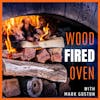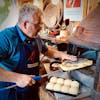Live Cook - Chicken Tikka Masala cooked in the Wood Fired Oven

This week, I am cooking up authentic Chicken Tikka Masala - live at my wood fired oven. I've got a few tips and tricks to help you cook this up at home. I explore the history of this dish - its origins may surprise you! Also, I discuss how to use stainless steel skewers deep in the wood fired oven, where your food will benefit from the hot brick dome.
You can grab this recipe at my website at below.
If you want to learn more about wood fired ovens, check out this great book: The Bread Builders: https://amzn.to/3x14Yjw
Please help support the show by using these links.
The Fire Brick Company
The Fire Brick Company specialises in producing world class Wood Fired Pizza Oven Kits.
I am very grateful to the Fire Brick Company for sponsoring the show. If you are thinking of building your own Wood Fired Oven, head on over to The Fire Brick Company website - www.thefirebrickco.com/WFOpodcast where they have a little something for you.
Become a Supporter of the show
Please consider supporting the Wood Fired Oven Podcast. I am very grateful to all those who support the show. Every little bit helps to cover costs. Support the show here.
Leave a review
Please leave a review on Apple Podcasts to let me know what you think of the show.
My website
Check out my website for episode show notes and links, wood fired oven tips and advice, pictures and recipes: woodfiredoven.cooking
Social
Instagram: marks_WoodFiredOven
Facebook: Wood Fired Oven Chronicles Facebook group
YouTube: @woodfiredovenpodcast
Twitter: @WFOPodcast
Recommended Wood Fired Oven books
Check out my favourite books. They have helped me a lot, both with cooking in my wood fired oven and learning to cook with fire. Some of these have also been recommended to me by friends of my podcast.
Mark (00:09):
Gday - Welcome to the Wood Fired Oven podcast where I take a deep dive into the techniques, recipes and history of wood fired oven cooking. My name is Mark an obsessed and somewhat curious fan of outdoor cooking - especially with my wood fired oven. Follow my podcast in your favourite app and listen in, as I go searching for the best recipes, tips and advice, to both supercharge our cooking skills and motivate you to light up your favourite outdoor cooking gear this weekend.
Mark (00:45):
Gday and welcome to this week's episode, where I'm going to be doing a live cook, making chicken tikka masala. Now, this is one of those dishes that I get a bit of a free pass with the kids. I Like my food hot. I like my food spicy, and this is one of the dishes where the kids let me do that. We've been having this dish now for about 10 years, all the way back to the days in Auckland, where I built my first tandoor oven out of a couple of very large, flowerpots. A little bit more on that later.
Mark (01:16):
A couple of years ago, when I finished building the wood fired oven, this was one of the first hot spicy dishes that I experimented with. And the results out of the wood fired oven are just fantastic. We usually accompany this dish with fresh homemade naan bread cooked directly on the floor of the brick oven. And it just is fantastic. It's one of those dishes that not only tastes great, especially if you get a little bit of that chicken crispy when cooking over the charcoals, but it also looks amazing and it's due to the tikka coloring, that I put in it. It just looks great. I've got a few pictures that you can take a peek at on my Instagram profile, if you're interested or check out WoodFiredOven.Cooking for the recipe for both this dish and the garam masala, which I make alongside.
Mark (02:04):
So this is one of those dishes that needs just a little bit of preparation. On day one, we create the chicken tikka and this gorgeous, bright orange chicken garam masala mix will stay in the fridge for about 24 hours to marinate and infuse into the chicken. It's pretty easy to make it. Throw in some, a paprika. I use a about eight tablespoons of home-made dry roasted garam masala. I've been making this garam masala recipe for about 20 years, and I would highly encourage you to take the extra 20 minutes and dry roast your own garam masala just before you prepare this. I do it in the wood fired oven, which has been on today and I've already dry roasted my spices off. So it use uses quite a bit of the garam masala. The recipe makes up a small jar of it. Eight tablespoons is required today. I've got the garlic I'm just preparing. Now you use a lot actually about 16 cloves of fresh garlic are going into the food safe container as well, and just love garlic. This is beautiful and fresh. You can find both recipes for the garam masala and the chicken tikka masala on my website, WoodFiredOven.Cooking. I've left a link in the show notes. So this is where I get a little free pass from the kids. I just put about one teaspoon of chili powder into the food safe container, but a little secret - sometimes I put an extra teaspoon and the kids don't know. So four teaspoons is what the recipe calls for. Try one, try two see how the kids end up liking it. Got six tablespoons of lemon juice here. These are lovely plump lemons off the tree in the garden. Now I use tandoori coloring to give this a gorgeous rich reddish orange color. It's very powerful stuff in terms of its color. It doesn't really taste of anything. I use one teaspoon. I have tried it with two teaspoons and that's probably a little too colorful. I'm putting in 500 mls of thick, natural yogurt. I use fresh ginger for this. I've got about a five centimeter piece. I use about two of those pieces in this recipe. Depends on how much you'd like your ginger. I've peeled it. And I'm just roughly chopping it and putting that into the container as well. And I'm also going to add in two cups of fresh coriander leaves as well. So what I'm going to do, I'm just going to mix all this together just gently by hand. Be very careful not to splatter the mixture because the food coloring, the tandoori food coloring will stain anything it touches. Putting a dash of salt and pepper in there as well. And I'm just going to mix that through. We're going to take that over to the food processor and whizz it up for about 30 seconds to get a nice, smooth, very bright orange paste. Be very careful don't let it splatter.
Mark (04:44):
Okay. So just going to blitz it for a few seconds. Okay. So I'm now putting the yogurt, bright orange gosh, into the food safe container where I'm about to place all the chicken thighs as well, really is super bright. And I like it like that, it really gets into the chicken and when it cooks, you get this lovely, burnt orange sort of look to, it reminds me of colour of, Jaffas for those Kiwi's (New Zealander's) out there. You know what I mean, gorgeous, sweets we used to eat in the movie theaters, but it's a beautiful, burnt orange color. And particularly when it gets singed and crisped up by the embers, towards the end of the cook at really does look spectacular. So I like to use around about three kilos of skinless chicken thighs.
Mark (05:32):
So I'm wearing some gloves when I do this part of the job. If I put my hands into this bright orange yogurt mixture, my hands are going to come out stained orange. So I've got the gloves on. I'm opening up about three kilos worth of skinless chicken thighs, and I'm placing those chickens into the yogurt mixture. Now, when you take out the chicken thighs, make sure that you flatten out the chicken thighs before you put it into the mixture. It's quite easy to put the thighs straight into the mixture. And after 24 hours, when you come to take them out to skewer them up on your skewers, you might find that the gorgeous Tikka mix, hasn't actually covered fully the chicken thighs. So just make sure that you push them into the yogurt and you move them around to make sure that every single piece being covered. Looking at the numbers here are probably got, oh, at least 25 chicken thighs here. So I always make a big batch of this. This gets used throughout the week. We often use it in wraps. We often use it in pies during the week as well. This is such a versatile recipe. It's just great. And now I'm going to pop this in the fridge for about 24 hours to do its magic. And we'll catch you again tomorrow.
Mark (06:48):
Welcome to my backyard and welcome to the front of my wood fired oven. So the fire has been chugging away for about three hours. I've had a large cast iron casserole, dish warming up in the oven, and now I'm just going to get the massala mixture underway. So I'm just heating up a little bit of oil and I'm, gently frying off some chopped onions, some cardamom pods, they provide a beautiful, unique flavor to this dish. Just chuck in the pods. I don't seed them here. I do seed the cardamom podswhen I'm making the garam masala, but not for the actual dish itself. I don't even bother to take the cardamom pods out of the finished dish either. We just lay them on the side of our plate, if we come across them while we eat. So popping them into the wood fired oven for a few minutes.
Mark (07:38):
Make sure your check your onions, just taking them out now having a quick stir. Yeah - they're looking good! Smells. Lovely. It's pretty easy to burn onions in a hot wood fired oven, so make sure that you look after them. Okay, I'm adding a little bit of garlic now and just going to fry that for a minute or so. Just stirring that through, just letting that sizzle away in the oven again for a couple of minutes. And now it's time to add the passatta .Now I've got two, large jars of tomato passata which I'm now going to add into the mix and that's bubbling away as that cold passatta hits the very hot cast on pan with the onions and the garlic. Yeah, that's smelling good. Okay. I'm just going to give that a good stir now. And then I'm going to put it back in the wood fired oven for about a quarter of an hour, 10 to 15 minutes or so, to get it simmering and bubbling away.
Mark (08:31):
I've got a small fire in the back of the oven. Going to lick this food with this flame for that 15 minutes. By the time this has finished cooking actually in an hour or so, the color gets nice and rich and dark. Okay. So now it's time to add in the cinnamon that freshly made garam masala, which I really hope you do try. It's not the same without it. Chili powder, plus maybe an extra teaspoon. Don't tell the kids and the sugar, and I'm just going to let that heat through for about a minute. Just stirring that through now, before it goes into the oven for its long sleep. I'm going to get the passatta jar now and just put a little bit of water in it. It looks like the dish will just need a little more liquid through the cook.
Mark (09:13):
Now it's time to add in the cream and I'm using about 600 mls of cream. Yeah, it's looking good. I'm adding in some ground almonds and that's going to thicken the sauce and actually provides a nice texture to the sauce as well. And I'm going to stir all of that through carefully and it looks really cool. You get these little spirals of cream going through your sauce - you just know that that's going to taste amazing. Yeah, that is smelling good. So the minimum amount of time that I would cook this, if I was in a hurry would be about 40 to 50 minutes and a cooler part of the oven. But in truth, this normally gets around about 90 minutes or so for me. So timing this out for when you're going to be cooking the chicken skewers over the embers is really important, honestly, though, as long as you keep an eye on the liquid content yet, I really don't think you can over cook this over a two hour period. It just gets darker and richer. I think this particular dish is very forgiving. So if you're new to your wood fired oven - give this one a go, I don't really think you can go wrong with it. And now that's heading into the oven for its long sleep.
Mark (10:11):
And that's all there is to it to make the gorgeous rich masala, which is a little bit like a glorified tomato soup if you think about it. Like I said, a little earlier in the show, I first started making this particular dish when I was living in Auckland. About 10 years ago, I built a tandoor door oven using a couple of very large flowerpots. Two upside down. So one pot stands normally on the ground. The other pot is upside down, sitting on top of it. So the large round openings are connecting. Wrapped that with chicken wire. I used refractory cement. And I seated that in an oil drum. Bricks in the base and poured vermiculite... vermiculite?.... vermiculite. Yeah, it looks a little bit like kitty litter around the sides between the oil drum and the tandoor. And it provided a very high level of installation. Capped it off at the top with some cement. And it made a fantastic tandoor oven. Brought some stainless steel to make some skewers with. And we enjoyed that for many years prior to moving to Australia. So it's a really lovely way to cook food in the tandoor oven. And this really is where the history of this particular dish comes from. The chicken tikka is obviously an Indian dish and it's very popular in India. The interesting part comes when you start researching the origins of the chicken tikka masala. Now, where do you think chicken tikka masala with the rich garam masala fueled gravy comes from?
Mark (11:39):
Well try Glasgow in Scotland. Well, most likely it came from Glasgow in Scotland. So the history to this dish is a pretty interesting. So the story goes that in Glasgow, back in 1971, a bus driver enjoyed his chicken curry at a particular restaurant, but he was complaining that it was pretty dry. So he went on to ask the waiter for some sauce to go with that. And so they paired it with, well, a tomato soup and thus began this rich rich history of chicken tikka masala. It has actually now been referred to as one of Britain's national dish in 2002 by the then British secretary, Robin Cook. And he hailed in his speech, the chicken tikka masala as a true modern symbol of multicultural Britain. And it really is a lovely take on combining these two cultures, the Brits love their curries, and I can see why this is just a fabulous dish. It has been suggested that this particular dish, the chicken tikka masala has been referred to as one of the first widely accepted examples of a fusion cuisine. And you can see why. Obviously the British love their curries with sauce. They like it wet, but it's a great, it's a great story. It's a great fusion of these wonderful, wonderful, wonderful foods. The actual origin of the chicken tikka, however extends back thousands of years ago, back to when the tandoor ovens were first invented. If you want more details of my tandoori oven, head over to my website, WoodFiredOven.Cooking, and send me a note and I'm happy to provide more details of that. Easy to do. It's fantastic. And it's a lot of fun.
Mark (13:29):
It's time to skewer up by the chicken. Now I've taken the chicken tikka mixture out of the fridge. It's been marinading for 24 hours. I brought it outside here to the wood fired oven. And the first thing I'm going to do is put on some gloves. Cause as soon as I handle that chicken, orange yogurt is going to get everywhere, including staining my hands. Now I've got about a dozen stainless steel skewers. Now I've experimented with a couple of different types of stainless steel skewers. The ones I'm landing on at the moment, they're about 18 mm wide. I ran about 650 millimeters long and are about two mm thick. So they are quite chunky skews. And I do find that they work their way through the chicken size pretty well. When I purchased these off eBay, when they came, they were fairly blunt. So I actually put them on the grinder and sharpen them up a little bit, not too sharp. So it would go through my hand if I missed when I was skewering them up. But the advantage of a flat stainless steel skewer is when you turn the skewer, the chicken turns with it. Now the previous skews I had were round. And so when you tried to turn a round skewer in the wood fired oven, it just rotated inside the chicken, and it was a bit of a disaster. So bought these flat skewers and it's pretty easy to cook. So I've got a food grade, plastic container next to the container containing the chicken. And I'm going to skewer up these, 25, 26 or so chicken thighs onto four skewers today. And this takes a couple of minutes. So take your time. Cause you really don't want to stick the skewer in your hand. And I put about six or so chicken thighs onto each skewer. I scare each thigh two to three times and get them as nice and flat as I can. I push the chicken up to about 20 centimeters to leave a handle for me to hold and to turn. And I'm going to be putting these horizontally into the wood fired oven, resting on two bricks. So a brick at the far end, near the sharp point and a brick near the handle, and I'll be reaching inside the oven to cook these over embers, but also getting the benefit of the retained heat coming out of the brick dome. Now I find if I cook these at the mouth of the oven, using a couple of bricks to support the skewers, it does actually affect the air flow coming into the oven. And so if you've still got a small fire at the back of your oven, while you cook this, you might find that it dies out. And that's happened to me a couple of times. So I've experimented cooking these both at the mouth and inside the oven, and my preference at the moment is to cook these inside the oven away from the entrance. So they get the heat from the top and the heat from the bottom of the embers, but also leaving that airflow free to suck into the oven to keep the fire and the embers alive.
Mark (16:16):
So that's the last of the chicken getting skewed up. Now, now they're looking great. They're just sitting there on the landing of the oven. So if you can imagine looking into my oven, I've got two brick side by side, well into the back of the oven, just to the left of center. And I've got another two bricks in front of it and I'm going to rest the skewers between these bricks. I've got about two skewers per set of bricks, and you can hear that gorgeous sizzling as the yogurt garam masala mixture is dripping off and kissing the embers below it. The smell coming out. It's just amazing. Okay. Here's a, here's a zoom in view, a close in view...well a close in sound. And it's getting a bit hot holding the microphone in the oven. Yeah, it's kind of worth it though. I reckon if you don't put your gear in harm's way, there's no point doing this stuff. Same goes for my a GoPro, which I managed to completely destroy in my wood fire oven a few months ago, while I was taking a shot on the fire in the back... poor thing melted and died. Anyway, it was still worth it. I got a little bit of footage before it died.
Mark (17:20):
All right. So all the chicken skewers are now in the oven on the bricks sizzling away. And it's going to take about 20, 25 minutes or so. I've got the masala mixture bubbling away there. Going to give it a stir and it's looking nice. It's now starting to darken up, which is great. Now about seven or eight minutes aside on those chicken skewers will be a starting point I think. Putting a little bit of salt and pepper in the masala and having a wee taste too. Yeah, that's good. It's a bit spicy...hope the Kids don't mind. Man. It's rich. It's so rich. I mean, that cream really does balance it out well. Just flipped each of the four skewers and I can already see on top of the chicken, edges of the chicken, ever so slightly starting to char up. And that's what you want. When you bring this out, you want to see lots of burnt little charry bits on the edges. You don't want to overdo it, but without that little char, you're just not going to get the flavors out of that mixture.
Mark (18:14):
So the skewers are now coming out of the oven. I've got the pot of masala mix on the landing here and I'm using tongs with my right hand, and in my left hand, holding the skewers over the cast iron pot and very gently pushing the chicken from the back of the skewer, pushing them off the skewers into the pot. And that's what you hear sizzling near as the chicken is entering the pot. That's a pretty quick way of doing it, actually using the tongs to get the chicken off. I like now to put the dish back into the oven for a about 10 to 12 minutes or so just to make sure everything's well warm through.
Mark (18:47):
I think it's also important too, to temperature check your chicken. And now I use my outdoor smokers a lot and I learned how to use my smokers in the Fahrenheit system. So I know when my chickens get to 165 Fahrenheit, it's about 75 degrees Celsius. It's a safe temperature inside the chicken. I'm pretty pedantic about that. I've ended up in hospital twice over the years with food poisoning. So I have no desire for that to happen ever again in my life. So I'm always now checking with a themopen temperature inside the chicken.
Mark (19:23):
Can hear its bubbling and sizzling away. It's out of the oven. It is looking fantastic. I've got gorgeous little crispy bits of chicken poking out of the top of the masala sauce, man, it smells great. It's rich, it's dark. It's reduced a little bit too. So those flavors are going to intensify. This is going to be fantastic. Thank you so much for joining me in my backyard in front of my wood fired oven on this late afternoon here.
Mark (19:43):
Please let me know if you try this recipe, I'd love to hear a how it's gone for you. Get in touch with me at my website, WoodFiredOven.Cooking, go to the questions tab and you'll find my email address there. If you like, you can hook up with me on Instagram at @marks_woodfiredoven. That's my zone too. So please do get in touch and let me know how you're finding this podcast and especially if you give this recipe a go. Stay safe, have fun and go cook with fire.
Mark (20:14):
If you’ve enjoyed this episode, please make sure you follow the Wood Fired Oven podcast in apple podcasts, Spotify or your favourite podcasting app. Please consider posting a review on apple podcasts…as that really helps the show. Don’t forget to check out WOODFIREDOVEN. COOKING for more tips, tricks and advice on cooking with fire. You can also see full episode notes and links. You can also post a question which I may feature on the show. I’m also on Instagram, twitter and facebook so head over to your favourite social platform and and get in touch. Thanks again for listening. Catch you next time.
New to the Wood Fired Oven Podcast?
If you are a new listener to the show, take a listen to these featured podcast episodes to get you started! You can also check our my episodes by topic or season.












